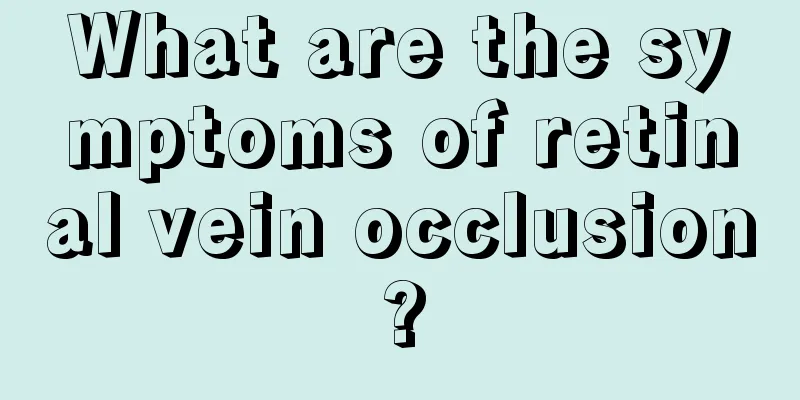What are the symptoms of retinal vein occlusion?

|
The retina is a critical and fragile part of the human body. Varicose veins and blockage in the retina can easily lead to some diseases. The most obvious symptom of varicose veins in the retina is decreased vision. It can easily lead to glaucoma in patients, and can also easily cause symptoms such as eye swelling or bleeding, so timely treatment is required. Retinal vein occlusion symptoms Early symptoms: The main symptoms are decreased central vision or partial visual field loss, but the onset is far less rapid and severe than arterial blockage, and partial vision can generally be retained. Late symptoms: 3 to 4 months after central vein occlusion, 5% to 20% of patients may develop iris neovascularization and secondary neovascular glaucoma. Retinal vein occlusion symptoms diagnosis The main symptoms are decreased central vision or partial visual field loss, but the onset is far less sudden and severe than arterial blockage, and partial vision can usually be retained. 3 to 4 months after central vein occlusion, about 5 to 20% of patients may develop iris neovascularization and secondary neovascular glaucoma. 1. Central retinal vein occlusion There are 2 types; (1) Lightweight; Also known as non-ischemic, hyperosmotic, or partial obstruction. Subjective symptoms are mild or absent. Depending on the degree of macular damage, vision may be normal or slightly reduced, and the visual field may be normal or slightly changed. Fundus examination: Early stage: the optic disc is normal or has slightly blurred borders and edema. The macular area is normal or has mild edema and hemorrhage. The arterial diameter is normal, the veins are tortuous and dilated, there are small or moderate flame-shaped and punctate hemorrhages along the four retinal veins, no or occasional cotton-wool spots, and the retina has mild edema. Fluorescein angiography showed normal or slightly prolonged retinal circulation time, mild fluorescein leakage from the venous wall, mild dilation of capillaries and a small amount of microaneurysm formation. The macula is normal or has mild punctate fluorescein leakage. Late stage: After 3 to 6 months, retinal hemorrhage is gradually absorbed and finally disappears completely. The macular area returns to normal or has mild pigmentation disorder; in a few patients, the macula presents dark red cystic edema, and fluorescein angiography shows petal-shaped fluorescein leakage, which eventually forms cystic scars and can cause decreased vision. In some patients, ciliary retinal vascular collaterals are formed in the optic disc, with a petal-like or wreath-like shape. Venous congestion and dilation are alleviated or completely recovered, but are accompanied by white sheaths. There were no or occasionally a small amount of non-perfusion areas, no neovascularization, and vision returned to normal or was slightly reduced. Some patients with mild central retinal vein occlusion may experience worsening of their condition and develop severe ischemic central retinal vein occlusion. (2) Heavy: Also known as ischemic type, hemorrhagic type, or complete blockage. Most patients have blurred vision and significantly decreased vision. In severe cases, vision is reduced to manual operation, and those with combined arterial obstruction may only have light perception. There may be visual field loss with dense central scotoma or peripheral narrowing. Fundus examination revealed that the optic disc was highly edematous and congested, with blurred borders that could be obscured by hemorrhage. There may be obvious edema, swelling and hemorrhage in the macular area, which may be diffuse edema or cystic edema. Cystoid macular edema is in the form of small bubbles arranged in a petal-like or honeycomb-like pattern. There may also be bleeding inside the cyst, forming a crescent-shaped or semicircular fluid level. The diameter of the arteries is normal or narrowed, the veins are highly dilated and tortuous like sausages, or they are undulating in a ring shape in the edematous retina. Due to lack of oxygen, the venous blood column is dark red. In severe cases, due to blood flow stagnation, red blood cells gather in the blood vessels, showing granular blood flow. Severe retinal edema is particularly evident in the posterior pole. A large number of punctate hemorrhages are distributed along the veins, and in severe cases, they cover the entire fundus. Bleeding from the superficial capillary layer is flame-shaped, while bleeding from the deep vascular layer is dot-shaped or patchy. In severe cases, large petal-shaped hemorrhages form around the optic disc and even enter under the internal limiting membrane to cause scaphoid preretinal hemorrhage. In more serious cases, the internal limiting membrane is penetrated to form vitreous hemorrhage. There are often cotton-wool spots on the retina, which increase in number as the disease worsens. These cotton-wool patches form due to inhibition of axoplasmic transport in the nerve fiber layer by acute precapillary arteriole occlusion. The b wave of the electroretinogram is reduced or extinguished, and the dark adaptation function is reduced. Fluorescein angiography showed prolonged retinal circulation time, occasionally prolonged brachio-retinal circulation time, dilation of optic disc capillaries, and leakage of fluorescein beyond the borders of the optic disc. Because the large area of bleeding obscures the capillary bed to form a non-fluorescent area, a large amount of fluorescein leakage can be seen from the gap in the venous wall. The capillaries are highly tortuous and dilated, forming numerous microaneurysms. There is punctate or diffuse fluorescein leakage in the macula. If there is cystic edema, petal-shaped or honeycomb-shaped fluorescein leakage may form. Generally, it enters the late stage 6 to 12 months after the onset of the disease. The optic disc edema subsides, and the color returns to normal or becomes lighter. Ciliary retinal collateral vessels are often formed on its surface or edge, which are ring-shaped or spiral-shaped and relatively thick; or new blood vessels are formed, which are curled or wreath-shaped and relatively narrow. Some can protrude into the vitreous and float in the fundus. Macular edema subsides, and there is pigmentation disorder or petal-shaped dark red spots, indicating that there has been cystoid macular edema in the past. In severe cases, retinal gliosis occurs, fibroblasts aggregate to form secondary epiretinal membranes, or scars mixed with pigments are formed, causing severe vision impairment. Most of the arteries become thinner and have white sheaths, and some are completely blocked and appear like silver threads. The diameter of the veins is irregular, and some are narrowed and accompanied by white sheaths, especially those caused by inflammation. Retinal hemorrhages and cotton-wool spots are absorbed, or hard exudates are left. The absorption is slow and is generally completely absorbed within 1 year or several years. Capillaries are occluded, and even arterioles and venules are occluded, forming large areas of non-perfusion. Some optic discs and retinas have neovascularization, which can lead to vitreous hemorrhage, fibrosis, tractional retinal detachment, and some may develop neovascular glaucoma. Fluorescein angiography showed thick collaterals or new blood vessels in the optic disc, the latter with a large amount of fluorescein leakage. The macula may be normal or have residual punctate or petal-shaped leakage, or may show punctate or flake-like translucency. The diameter of the artery becomes narrower, and the venous wall has little leakage or only has localized leakage. Capillary occlusion forms large non-perfused areas, which start from the peripheral part of the retina in the form of islands and then connect into sheets. In severe cases, the areas may extend to the equator and even around the optic disc. Arteriovenous shunts, microaneurysms and/or neovascularization are often present near the non-perfused areas. Intraocular pressure is normal in the early stages of this disease, but may rise sharply in the late stages if combined with neovascular glaucoma. 2. Hemi-retinal vein occlusion During the development of retinal blood vessels, the hyaloid artery passes through the embryonic fissure and enters the optic cup. When the embryo is 3 months old, two veins appear on both sides of the artery and enter the optic nerve. In normal people, they merge into the central retinal vein in the optic nerve behind the optic disc. Usually one of the branches disappears after birth, leaving only one main trunk. However, in some people it may remain, forming two main venous trunks. Hemi-occlusion is when one of the main trunks is blocked at the lamina cribrosa or within the optic nerve. This type of obstruction is relatively rare in clinical practice, with an incidence rate of 6% to 13%. Usually one-half of the retina is affected. Occasionally, 1/3 or 2/3 of the retina may be affected. Its clinical manifestations, course, and prognosis are similar to those of central retinal vein occlusion. If there are large areas of non-perfusion, neovascular glaucoma may also develop. 3. Branch retinal vein occlusion The temporal branch is most commonly affected by branch vein obstruction, accounting for 90% to 93%, among which the superior temporal branch is the most common, accounting for 62% to 72%. The nasal branch is rarely obstructed, with an incidence of 1.5% to 3.0%. The prognosis of macula small branch obstruction is better than that of main branch obstruction, because the drainage range of macula small branches is small and the capillary layer there is thick, so the possibility of producing non-perfused areas is small, and even if they occur, the area is very small, so the possibility of causing late complications such as neovascularization is small. In contrast, main trunk obstruction is associated with more complications. |
<<: What are the symptoms and consequences of mercury poisoning?
>>: Can aloe vera capsules cure constipation?
Recommend
How long is the incubation period of cervical cancer?
It takes about 5 to 10 years from HPV infection t...
How to quickly relieve dry stool?
Defecation every day is a very important thing. C...
Is chemotherapy effective for liver cancer? It has a certain effect
Cancer patients actually have different degrees o...
What are the folk remedies for treating teratoma
With the development of the economy, the environm...
What is sinus arrhythmia? You need to know these
Sinus arrhythmia is a type of cardiac arrhythmia....
What kind of shoes are better to wear when driving?
In today's rapidly developing society, vehicl...
Is liver cancer a digestive tract cancer? Be careful to prevent these 5 common digestive tract cancers
Digestive tract cancer is a disease in which canc...
What should you pay attention to in your diet for colorectal cancer
What should you pay attention to in your diet for...
How many types of influenza viruses are there?
Influenza viruses include three types: A, B, and ...
How to treat minor cerebral hemorrhage?
Cerebral hemorrhage is a common phenomenon among ...
How long does it take to get pregnant with colon cancer
If a colon cancer patient is currently undergoing...
Can people with high cholesterol drink yogurt?
Due to our eating habits and daily living habits,...
Head acupoint massage techniques
Tui Na in Chinese medicine is a traditional massa...
The basic types of lung cancer are as follows:
Many people must have heard of lung cancer, but h...
How to relieve scalp bleeding
The human cerebral cortex is full of nerves. The ...









